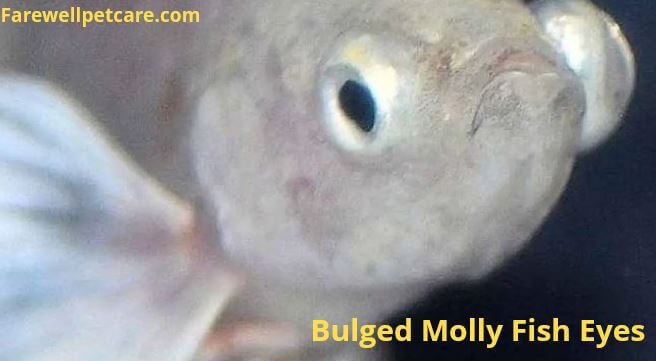A molly fish can suffer from several diseases. Famous among them is the disease that leaves your molly fish eye bulging. This condition can make you wonder what molly fish eye bulging could be, its causes, and their remedies to help the fish live a normal lifestyle.
Molly fish eye bulging is a disease that makes your fish’s eyes pop out or protrude abnormally from the socket. It’s also called Popeye (Exophthalmia) disease, mainly caused by pathogens like bacteria or fungi, injury, and poor water conditions. You can treat the disease with Epsom salt and antibiotics like Kanaplex.
Stay tuned to learn more about molly fish eye bulging, its causes, and how to manage it for a healthy, happy-looking molly fish.
Molly Fish Eye Bulging: Its Causes and Treatment

Popeye disease doesn’t result from a specific cause but rather a variety, as we have already seen.
The following are the main causes of molly fish eye bulging and how to treat them:
1. Infections
Infections are the common causes of Popeye disease in molly fish. Usually, both eyes swell almost uniformly, showing that the fish is suffering from pathogen infections.
Infection-causing pathogens in molly fish include:
- Bacteria
- Fungi
- Parasites
Bacterial infections are opportunistic. Once the eye gets a minor injury and some fluids begin forming inside, bacterial microorganisms get the perfect chance to invade the eye.
At this point, your fish has low immunity – making it easy for bacteria to attack and infect. As the bacteria multiply rapidly, they release toxins that damage the delicate membrane structures of the eyes. Eventually, your fish’s eyes become inflamed and swollen.
Similarly, fungal infections contribute to popeye disease by entering the fish’s eye through open wounds—however small that wound could appear around the eye.
The hyphae feeds from the eye tissues causing an inflammatory response and subsequent eye swelling. The main trigger of fungal attacks is poor water quality in the aquarium.
Treatment
For infections, get the best available antibiotics to help with emergency treatments. Remember to consult an aquarist expert or your veterinarian for the best medicines to administer. Meanwhile, Kanaplex is a good one for a start.
It’s worth mentioning that all bacterial infection cases must be quarantined in a separate hospital tank to avoid infecting other fish in the main aquarium.
Find Out: Why Is My Molly So Fat? 4 Main Reasons and Their Remedies
2. Injury
Another common cause of eye swelling in molly fish is the physical injury it might sustain from fighting or knocking against objects in the tank. In both cases, there is damage to eye tissues which makes them swell.
Usually, the eye tissue integrity is disrupted due to the knocks. It then swells in response to the impact.
It’s not always the case that swelling occurs immediately. Sometimes, the process can be gradual.
Other causes of injury to your fish’s eyes can happen due to constant rubbing of its eyes against abrasive surfaces like gravel or decorations in the aquarium. Eye tissues usually swell if the fish keeps doing this for some time.
Moreover, your fish handling techniques can inflict injury, especially if you handle it roughly when cleaning the tank. For example, using a sweep net with sharp edges can injure your fish’s eyes when it accidentally comes into contact with the fish.
Molly fish eye bulging resulting from injury can be unilateral, affecting one eye rather than both. However, popeye will affect both eyes.
Treatment
Injury treatment is crucial and should be done fast to avoid secondary infections by opportunistic bacteria and fungal organisms.
You can use a suitable aquarium salt like Epsom to relieve the fish from the pain inflicted by the injuries.
If there are many decorations and objects in the tank, remove them to prevent further damage.
For the case of aggressive tank mates, transferring such fish to another tank will help reduce aggressive activities.
That said, find out how many mollies should be kept together for safety.
3. Poor Water Conditions
Some fish may suffer from various diseases, including Popeye if the water quality goes down. Therefore, you must maintain a clean and fresh tank all the time for the fish’s safety.
Some poor water conditions that predispose molly fish to popeye disease include the following:
- Poor oxygen circulation in the tank due to overcrowding
- High ammonia levels
- Increased nitrates and nitrites
- Unfavorable pH – highly acidic or highly alkaline
It’s worth noting that you’ll be encouraging degrading conditions by not maintaining the tank well and regularly. Eventually, these conditions affect your fish’s health, reducing its immunity and exposing it to Popeye.
Treatment
Ensure you maintain a favorable water chemistry environment for your molly’s optimal health.
Check the different water parameters and correct them based on the following quick guide:
- A pH level of above 7.2 is conducive for optimal health
- A temperature range of 70 to 80℉ (21.11 to 26.67℃). Unheated aquariums are still great for mollies.
- Maintain nitrates at less than 20 parts per million
- No nitrites should be present in the water
- No ammonia should be available in the tank
- Provide slightly hard water—you can mix crushed coral in the aquarium.
Moreover, you should remove any excess fish feed remains that settles on the floor or suspended in water. These are the primary sources of ammonia and other harmful gases in the aquarium.
Why Do Molly Fish Eyes Bulge?

Molly fish eyes bulge due to poor water chemistry, physical injuries resulting from fighting with other tank mates, and infections. For some reason, fish will also develop bulging eyes because of their genetics and poor diet.
Fast forward, we’ve seen the effect of poor water chemistry on a molly fish’s health. It weakens the fish’s immunity, exposing it to Popeye disease.
On the other hand, infighting can result in severe injuries among tank mates.
In most cases, injuries that occur due to such fights are unilateral. This means the damage may only be on one eye instead of both. The latter is a primary indication of an infection.
Furthermore, injuries are expected when the molly fish collides with objects in the aquarium. The fish may accidentally hit a decoration in the water. Consequently, it’s recommended to limit the number of decorations in the aquarium to avoid frequent problems that could lead to trauma.
You should also find out if your molly fish has naturally-bulged eyes. Some fish may have genetic issues that cause abnormal eye structure development. For such mollies, the abnormalities become more pronounced with time, leading to bulging eyes.
Common Signs of Popeye in Molly Fish
Generally, one of the most common signs of popeye in molly fish is swollen or protruding eyes. One or both eyes may appear swollen or bulging, giving the fish a ‘popeye’ appearance.
Here are other prominent signs of Popeye in molly fish:
- Cloudy or discolored eyes, especially when the condition advances
- Red or inflamed eye area to show an irritated fish.
- Eye socket stretches
- Sometimes you may see blood in the eyeball
- The eyeball may rapture when the disease becomes severe
- The fish becomes inactive, usually resorting to the bottom of the tank
- Loss of appetite
- The entire body becomes swollen
- Infected fish exhibit erratic swimming patterns. It can’t maintain a stable swimming balance consistently.
- The fish keeps rubbing or scrubbing its eyes on objects or the aquarium because it feels uncomfortable.
Once you notice such symptoms, don’t hesitate to ask your veterinarian for urgent help. You need an accurate diagnosis, and that’s the work of a veterinarian, who should determine the appropriate course of action.
How Do You Treat Popeye in Molly Fish?
You can treat popeye in molly fish by providing the following:
- Good water quality
- Clear the aquarium of any dangerous objects
- Provide a nutritious diet
- Provide suitable antibiotics if the popeye is due to infections like bacteria or fungi
It’s worth noting that prevention is always better than cure. Therefore, the best way to prevent Popeye in your molly fish is by maintaining high-quality aquarium conditions.
You must maintain water chemistry parameters such as a high basic pH, low nitrates, no ammonia nor nitrites, and a favorable water temperature.
Moreover, it’s advisable to decongest the aquarium. This reduces trauma that often leads to injuries due to excitement.
Decongesting creates ample space for fish to roam freely without the risk of knocking against something.
As for the diet, give your fish nutritious feed. Consider high-quality pellets and flakes with a variety of vegetables such as blanched zucchini, squash, lettuce, and small pieces of cucumber.
Final Thoughts
Knowing the causes and remedies for Molly fish eye bulging is essential for any responsible fish keeper.
Whether it’s due to poor water conditions, bacterial infections, or physical injuries, identifying the root cause early on can prevent serious complications and the potential loss of your beloved fish.
You can prevent eye issues in your molly by ensuring the right water chemistry and tank conditions and providing a balanced diet.
Additionally, you should address any signs of infection or injury promptly with proper medications and quarantine procedures to aid in the healing process.
Prioritizing your Molly fish’s well-being and implementing these remedies will ensure a healthy and thriving aquatic companion for years to come.

